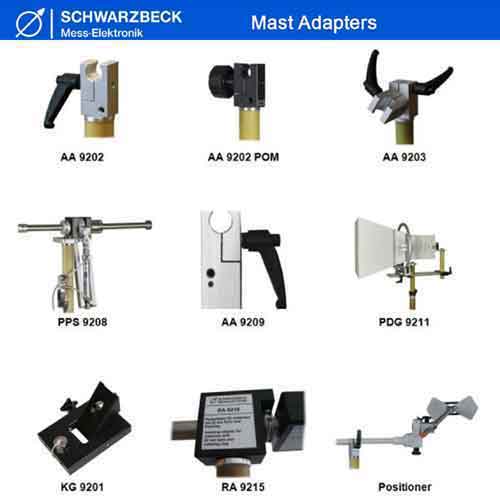Schwarzbeck Wireless Test
Log Periodic Antennas
|
ESLP 9145 - Microwave
Wireless Log Periodic Antenna
|

1 - 18 GHz
700 MHz to 20 GHz Usable |
|
Frequency Range: |
(0.7) 1 - 18 (20) GHz
|
|
Polarisation: |
linear |
|
Pattern Type: |
directional |
|
Max Power: |
20 W |
|
Connector: |
Type N female |
|
Impedance: |
50 Ω nominal |
|
|
|
|
Length: |
0.50 m |
|
Width: |
0.24 m |
|
Height: |
0.04 m |
|
Weight: |
0.9 kg |
|
Mounting: |
22 mm tube |
|
Recommended Adapter: |
AA 9203 / AA 9202 |
A new low attenuation cover allows
measurements with radome.
Datasheet ESLP 9145
Radiation Pattern
VSWR
Fieldstrength
|
|
USLP 9143 B - Log Periodic Wireless Test Antenna
|


0.2 - 7 GHz
180 MHz to 8 GHz Usable
|
|
Frequency Range: |
(180) 200 MHz - 7 (8) GHz
|
|
Polarisation: |
linear |
|
Pattern Type: |
directional |
|
Material: |
Aluminium |
|
Max Power: |
200 W (<500 MHz) |
|
Connector: |
Type N female |
|
Impedance: |
50 Ω nominal |
|
|
|
|
Length: |
0.89 m |
|
Width: |
0.78 m |
|
Height: |
0.06 m |
|
Weight: |
1.2 kg |
|
Mounting: |
22 mm tube |
|
Recommended Adapter: |
AA 9203 / AA 9202 |
Datasheet USLP 9143B
Short
Measuring Distance
|
|
USLP 9142 - Schwarzbeck Log Periodic Wireless
Test Antenna
|

0.7 - 5 GHz
700 MHz to 8 GHz Usable
|
|
Frequency Range: |
0.7 - 5 (8) GHz
|
|
Polarisation: |
linear |
|
Pattern Type: |
directional |
|
Material: |
Aluminium |
|
Max Power: |
50 W |
|
Connector: |
Type N female |
|
Impedance: |
50 Ω nominal |
|
|
|
|
Length: |
46 cm |
|
Width: |
20 cm |
|
Height: |
|
|
Weight: |
0.5 kg |
|
Mounting: |
22 mm tube |
|
Recommended Adapter: |
AA 9203 / AA 9202 |
Datasheet USLP 9142
Radiation Pattern
|
|
VUSLP 9111-1000 - Log Periodic Antenna
|

0.8 - 3 GHz
750 MHz to 4 GHz Usable
|
|
Frequency Range: |
(0.75) 0.8 - 3 (4) GHz
|
|
Polarisation: |
linear |
|
Pattern Type: |
directional |
|
Max Power: |
300 W (1 GHz) |
|
Connector: |
Type N female |
|
Impedance: |
50 Ω nominal |
|
|
|
|
Length: |
46 cm |
|
Width: |
22 cm |
|
Height: |
6.5 cm |
|
Weight: |
0.9 kg |
|
Mounting: |
22 mm tube |
|
Recommended Adapter: |
AA 9203 / AA 9202 |
Datasheet VUSLP 9111-1000
|
|
VUSLP 9111-400 - Schwarzbeck Log Periodic Wireless Test Antenna
|

0.4 - 3 GHz
340 MHz to 4 GHz Usable
|
|
Frequency Range: |
(340) 400 MHz - 3 (4) GHz
|
|
Polarisation: |
linear |
|
Pattern Type: |
directional |
|
Max Power: |
300 W (1 GHz) |
|
Connector: |
Type N female |
|
Impedance: |
50 Ω nominal |
|
|
|
|
Length: |
64 cm |
|
Width: |
45 cm |
|
Height: |
7 cm |
|
Weight: |
1.3 kg |
|
Mounting: |
22 mm tube |
|
Recommended Adapter: |
AA 9203 / AA 9202 |
Datasheet VUSLP 9111-400
Radiation Pattern
|
|
AA 9202


|
Mast Adapter for Antenna Mast System AM 9144
with 22 mm hole for most Antenna models.
3/8" and 1/4" camera threads
polarization continuously adjustable
Datasheet AA 9202
|
|
AA 9203

|
Mast Adapter for AM 9144 with 22 mm hole for
most Antenna models
3/8" and 1/4" camera threads polarization and
elevation continuously adjustable
Datasheet AA
9203
|
|

The Log Periodic Dipole Antennas normally consists of a series of half wave
dipole "elements" each consisting of a pair of metal rods, positioned along
a support boom lying along the antenna axis. The elements are spaced at
intervals following a logarithmic function of the frequency, known as d or
sigma. The length of the successive elements and the spacing between them
gradually decrease along the boom. The relationship between the lengths is a
function known as tau. Sigma and tau are the key design elements of the LPDA
design. The radiation pattern of the antenna is unidirectional, with the
main lobe along the axis of the boom, off the end with the shortest
elements. Each dipole element is resonant at a wavelength approximately
equal to twice its length. The bandwidth of the antenna, the frequency range
over which it has maximum gain, is approximately between the resonant
frequencies of the longest and shortest element.
The elements are equipped with soft plastic caps to avoid
injury and for optical reasons. Due to dielectric loss the soft plastic caps
are heating up when the antenna is dissipating around 500 W of power.
Occasionally the plastic caps get deformed or even damaged.
We
recommend to remove all soft plastic caps if you plan to use more than 500
W. The influence of the plastic caps on electrical antenna data is
negligible small in the specified frequency range.
|



